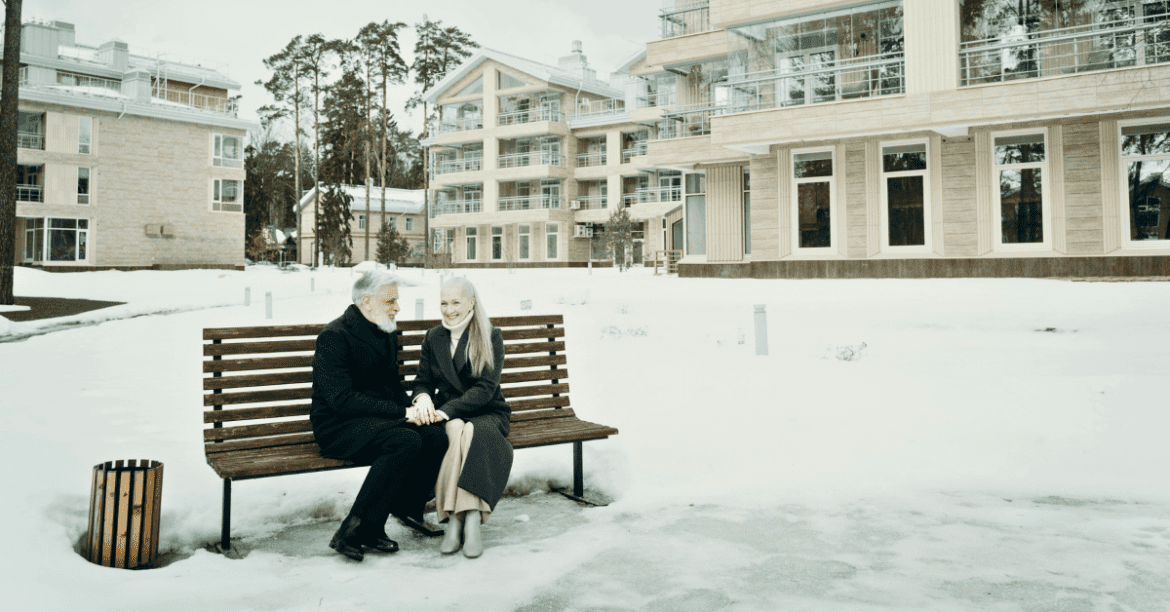Winter is a beautiful time of year, but it can also be treacherous for older adults who aren’t used to the extreme cold. Snow, ice, and reduced daylight make walking outside much more complex, with injury hazards. But don’t worry – there are many ways to stay protected this winter season!
This blog post will provide simple indoor and outdoor winter safety tips for seniors, so they can enjoy the chilly months in peace. In addition, we will list down the essential items that older adults must have to stay safe and warm throughout the cold season. So, read on to learn more!
What are the dangers of winter for the elderly?
They say that “there’s no such thing as bad weather, only bad clothing,” which is not always true when it comes to seniors. That is why it is crucial to be aware of the potential dangers of the cold season and have some senior safety tips for winter ready. Below are some of the significant dangers of winter for the elderly.
1. Higher risk for falls
Winter can pose a higher risk of falls among elderly individuals. Because cold weather can cause slippery conditions both outdoors on sidewalks and streets as well as indoors on hardwood floors if there isn’t proper carpeting. Wearing appropriate shoes with good traction can help prevent this risk factor from occurring.
2. Frostbite and purple fingertips
Two more dangers of winter are frostbite and purple fingertips syndrome. Frostbite happens when the skin and tissues freeze due to low body temperature in the elderly. Symptoms of frostbite include numbness, tingling, and pain. Besides, while exposed to freezing temperatures, the oxygen supply in the blood often reduces. As a result, it causes the skin to turn blue or purplish due to poor blood circulation.
3. Dehydration
Dehydration is another health concern common among older adults during the winter months. That is because they rarely feel as thirsty when it’s cold or spend less time outside in the sunshine – two factors that would typically prompt them to drink more water throughout the day.
4. Risk of infectious disease
Winter can pose serious health risks for older adults, including colds, flu, Pneumonia, and other infectious diseases. This is because their immune systems are not as strong as they once were. If not treated immediately, these infections can lead to hospitalization and even death.
5. Worsened respiratory illnesses
Respiratory illnesses like asthma often worsen in winter due to the cold air making it harder for them to breathe properly. Also, germs tend to spread more quickly within indoor environments during winter where elders congregate, such as retirement homes or nursing facilities.
6. Increased joint pain
Cold weather can add a whole new level of difficulty for seniors with arthritis due to increased inflammation in joints. For those with chronic joint pain, this time of year may be incredibly challenging due to increased discomfort and soreness resulting from cold temperatures.
7. Increased risk of depression
Elderly individuals are also at an increased risk of experiencing depression in the wintertime due to lack of sunlight exposure leading to decreased serotonin levels. Also, they might feel isolated or cut off from social activities since many places close down when it gets too cold, and people tend not to go out much.
Winter safety tips for seniors
As there are several potential dangers of cold weather for seniors, it is crucial to be careful and take necessary measures to stay safe. For your convenience, we have prepared two separate lists of indoor and outdoor winter safety tips for older adults. Let’s take a look at them!
Indoor winter safety tips for seniors
Cold winter weather can be a hazard to homebound seniors or those living in nursing homes or other care facilities. Below are some home safety tips for seniors in the winter to keep them warm and safe.
1. Ensure all heating components are working
One of the key winter home safety tips is to check whether all the heating tools, such as wall heaters and furnaces, are in working order. If not, then they should be serviced before the chilly season starts.
2. Regular vacuuming and decluttering
Vacuuming regularly will help eliminate air pollutants. Besides, it’s always essential to declutter hallways and walkways to ensure the path to the bathroom and common areas is clear to avoid fall hazards. Also, periodically check smoke alarms to make sure that they are working properly.
3. Exercise indoors
Working out boosts circulation and helps maintain overall health. In addition, regular indoor activities such as yoga, tai chi, or swimming can help seniors stay active during the winter months.
4. Make safety modifications
Making some home safety modifications during winter can reduce the risk of injuries. For example, install grab bars in the bathroom and shower area, place non-slip mats in tubs and showers, and install lighting along pathways to reduce fall risks.
5. Eat a healthy diet
Try to have a balanced meal plan with high-nutrient foods such as fruits, vegetables, and lean proteins. These foods can boost energy levels and support immunity during the colder months. Also, drink plenty of fluids to stay hydrated and avoid sugary drinks. Additionally, stock a good amount of food supply and canned goods for extreme situations.
6. Avoid using stoves or ovens for extra warmth
Using stoves or ovens for extra warmth can pose potential fire hazards and must be avoided at all costs. Investing in a blanket warmer (electric heated blankets) or an electric mattress pad can provide additional warmth safely instead.
7. Stay connected with family members
Loneliness can have profound mental health implications for seniors over 65. So, staying connected with family members via phone calls or video chats is important during winter months when outdoor activities may be limited due to weather conditions. Make sure your phone and tablets are regularly charged. You may also want to buy a power bank in case of a power outage.
8. Ensure adequate access to medication
Another essential winter safety tip for homebound seniors is to stock up on necessary medications before severe winter storms. By doing so, they won’t have to step out during hazardous conditions. Besides, prolonged weather situations may cause the closure of pharmacies.
Outdoor winter safety tips for seniors
Even though it’d be ideal to stay indoors during harsh winter months, sometimes stepping out cannot be avoided. However, senior citizens should be highly cautious while going out during the cold season. Below are some outdoor winter safety tips for older adults.
1. Check weather conditions beforehand
It is crucial to check weather conditions before going out during winter months. Besides, make sure to stay up-to-date with any weather warnings and advisories issued by local authorities.
2. Wear multiple layers of clothing
Wearing multiple layers of clothing helps to trap in body heat. So, older adults should wear lightweight, warm clothing such as hats and scarves, gloves, thermal underwear, fleeces, sweaters or vests, and insulated jackets.
3. Be mindful of slippery streets
Be mindful of slippery streets, sidewalks, driveways, decks, and porches when venturing outside in winter weather conditions. Also, refrain from moving snow or snow plows yourself, as it can cause injuries. Instead, take a different route or ask for help.
4. Avoid strenuous activities
Avoid strenuous physical activities outdoors during winter. Use extreme caution when shoveling snow as it can put an immense strain on older muscles resulting in injury if done incorrectly. If it’s too difficult to shovel yourself, hire someone who has experience doing so.
5. Wear non-slip boots
Wear winter boots with good tread and traction to prevent slipping on icy surfaces. If you’re going out in snowy weather, waterproof boots are essential to keep your feet dry. Many boots are designed specifically for snow and have additional insulation and fur lining, which helps keep your feet warm in cold temperatures.
6. Carry assistive devices
Older adults who have arthritis or balance issues should carry assistive devices while walking on slick surfaces. Some of the assistive devices include cane, walkers, or walking sticks.
7. Avoid driving if possible
Avoid driving during inclement weather if possible. However, if that is not an option, ensure you’re well prepared by servicing your car regularly before winter hits. Also, make sure your vehicle has a full gas tank before hitting the road and properly clear off any snow accumulation on your windows/mirrors, as visibility is always key when driving in wintery conditions!
8. Monitor body temperature
Senior citizens tend to be more sensitive to cold temperatures than younger people, so monitoring body temperature outdoors in winter is important. Also, be aware of signs of Hypothermia, such as shivering, confusion, drowsiness, slurred speech, and seek shelter immediately if you start feeling too cold.
What are the must-have winter items for the elderly?
Winter can be a challenging season for the elderly, as cold temperatures can pose a variety of health risks. To keep elderly individuals safe and warm during the winter season, there are certain items that are must-haves. That includes:
- Warm winter coats
- Thermal clothing
- Scarves and gloves
- Heated blankets
- Socks and hats
- Hot water bottles
- Waterproof footwear with good traction
- Flashlights and batteries
- Power banks and chargers
- Non-slip mats and rugs
- Space heater
- Electric kettles
- Canned food
Final thoughts
As the snow begins to fall and the temperature gets colder, it’s essential to make sure that our elderly loved ones are staying safe. From wearing warm clothes to installing heating components, stocking up on food and supplies, and staying mindful of weather conditions – there are many safety measures that can be taken to stay warm and comfortable, both at home and outdoors.
We hope by following the winter safety tips for seniors, our elderly loved ones will stay safe and healthy throughout the season. And if you know a senior who might need help with some of these tasks, don’t hesitate to lend a hand. We all need to look out for each other in times like these. Thanks for reading!
FAQs
- What is Hypothermia in elderly?
Hypothermia in elderly is a condition in which the body cannot maintain its normal temperature, and the internal temperature drops below 95°F (35°C). Elderly individuals are at an increased risk of developing hypothermia due to age-related changes in the body. As we age, our bodies become less capable of maintaining a consistent internal temperature, so we are more likely to be affected by cold temperatures.
Symptoms of hypothermia in elderly individuals may include shivering, confusion, drowsiness, shallow breathing, weak pulse or slow heartbeat, slurred speech, and impaired coordination. If left untreated for too long, hypothermia can lead to organ failure and death.
- What temperature is dangerous for elderly?
For elderly people, any extreme temperature can be dangerous. Frigid temperatures can cause hypothermia, which is a condition in which the body’s temperature drops below 95 degrees Fahrenheit and can lead to death if not treated promptly.
- Why are old people always cold?
Old people often feel the cold more than younger adults do because their bodies are not as efficient in regulating their temperature. Below are some of the potential reasons for old people being cold all the time:
- Slower blood circulation to the extremities like hands and feet.
- Drop in temperature due to decreased metabolic rates, less muscle mass, and fat.
- Some medications that elderly individuals take also can cause a body temperature to drop.
- Medical conditions such as anemia, Raynaud’s syndrome, or hypothyroidism.
- Low levels of hormones like estrogen or testosterone may also contribute to feelings of coldness.
- Lack of physical activity and body movement.

